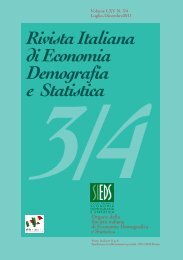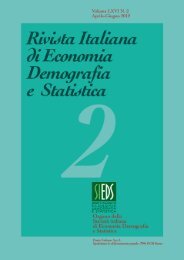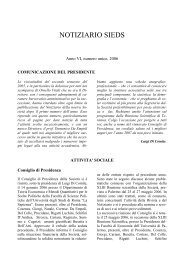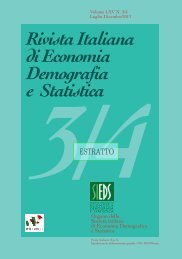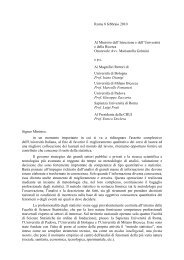rivista italiana di economia demografia e statistica - Sieds
rivista italiana di economia demografia e statistica - Sieds
rivista italiana di economia demografia e statistica - Sieds
You also want an ePaper? Increase the reach of your titles
YUMPU automatically turns print PDFs into web optimized ePapers that Google loves.
Rivista Italiana <strong>di</strong> Economia Demografia e Statistica<br />
signal for income poverty, while if the curve is below the 45° line , this means that<br />
health acts as a contra-in<strong>di</strong>cator for income poverty.<br />
The area under the ROC curve can be a measure of the extent to which two<br />
<strong>di</strong>mensions of poverty are correlated in the sense of identifying the poor, we report<br />
therefore in table 1 the estimates of the areas in both waves (ROC1 and ROC2).<br />
As suggested by Madden (2008), we transformed the or<strong>di</strong>nal measure of selfreported<br />
health into a car<strong>di</strong>nal one using an ordered probit model for each country<br />
and wave using as in<strong>di</strong>pendent variables age, gender, education, marital status,<br />
information about chronic deseases or <strong>di</strong>sabilities and income, than we take the<br />
linear pre<strong>di</strong>ction of this ordered probit and re-scale it so that it takes a value from 0<br />
to 1 to maintain the relative approach to poverty.<br />
After having analysed the correlation between health and income, we compute<br />
the multi<strong>di</strong>mensional indexes of poverty, using the bi<strong>di</strong>mensional union and<br />
intersection headcount ratios and the Bourguignon and Chakravarty’s index (1),<br />
that can be viewed as a CES (Constant Elasticity of Substitution) weighted average<br />
of the Foster-Greer-Thorbecke poverty index.<br />
P θ α (X;z) = 1/n Σ n i=1{{[max(1-xi1/z1,0)] θ + b θ/α [max(1-xi2/z2,0)] θ } α/θ } (1)<br />
More precisely the union headcount ratio identifies those who are poor in any<br />
one of the two <strong>di</strong>mensions considered, while the intersection headcount ratio is<br />
more restrictive and requires to be poor both in health and income. The<br />
multi<strong>di</strong>mensional index of Bourguignon and Chakravarty takes into consideration<br />
also the effect of the substitutability between attributes, by satisfying the nondecreasing<br />
poverty under correlation increasing switch (NDCIS) or the converse<br />
property NICIS. The NDCIS demands that, if the two attributes are substitutes<br />
(complements), poverty should not decrease (increase) under a correlation<br />
increasing switch, i.e. an increase in the correlation between the attributes. The<br />
poverty thresholds are given by z1 and z2 and b is the relative weight given to<br />
poverty <strong>di</strong>mension 2, the parameter α reflects instead the relative weight attached<br />
to extreme poverty, while θ determines the elasticity of substitution between<br />
the shortfalls of the <strong>di</strong>fferent attributes. The Bourguignon–Chakravarty index<br />
satisfies NDCIS or NICIS depen<strong>di</strong>ng upon the relative values of α and θ, with<br />
NDCIS hol<strong>di</strong>ng when α > θ.<br />
65



